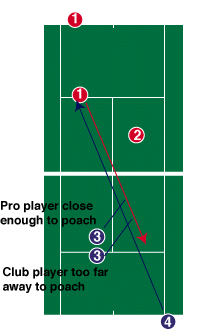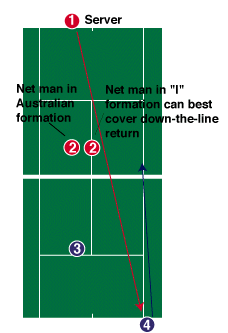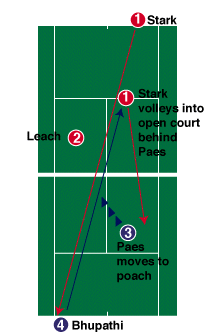|
TennisOne Lessons


ATP World Doubles Championship: Lessons Learned
by Kim Shanley, TennisONE
Publisher and Editor-in-Chief
Once a year you can see a televised tennis event that features just doubles.
This was the November 22-23 ESPN broadcast of the ATP World's Doubles Championship
from Hartford, Connecticut. Nursing a bad cold that prevented me practicing
my own 4.0 version of doubles, I sat down to learn what the masters could
teach me. Not surprisingly, they taught me a lot.
Watching the pros is both exhilarating and depressing. It's exhilarating
to see Jonathan Stark rocket an ace into the back wall of the arena or see
Leander Paes feather a drop volley in front of his helpless opponents. But
it's also depressing because they are playing a different game than most
of us can ever hope to play. So, no, we can't hit the same
shots they do. But we can learn to play the game the way they
do--and apply those strategies and tactics at our own level of play.
First the results of the two televised matches.
Saturday's Semi-Finals Match
Leander Paes, Mahesh Bhupathi defeated Sebastian Lareau, Alex O'Brien,
6-1, 2-6, 7-6 (7-5)
Finals Match
Rich Leach, Jonathan Stark defeated Leander Paes, Mahesh Bhupathi, 6-3,
6-3, 7-6 (7-3)
Lessons Learned
Lesson #1: "Doubles Is A Different Game"
Whenever a good singles player loses at doubles, you hear this maxim
trotted out by the wily old doubles players at your club. But is it really
true? Or is it the snobbery of players too old to play a decent game of
singles? As Bill Tilden explains, the wizened old veterans at your club
(at least on this issue) are truly wise:
Singles is essentially a baseline game with occasional net attacks.
Doubles is a net game, with as little back-court play as possible. Singles
is a game of ground strokes, doubles is serve, volley, and smash, with
the ground stroke an added necessity in returning serve. -- "How to
Play Better Tennis"
Certainly both the semi-final and finals ATP matches amply demonstrated
Tilden's edicts. The teams that served, volleyed, and returned serve most
effectively, dominated the play around the net and won the match.
Lesson #2: "Doubles is a Science of Exact Angles"
Running and re-running the ATP Doubles Championship matches on tape,
I noticed several points that illustrated Bill Tilden's edict that "doubles
is a science of exact angles."
a. Positioning of Net Player on Receiving Team.
 When playing the net position on the receiving
team, most club players position themselves on the service line or one to
two steps behind it. All the pro teams in the ATP Doubles Championships
placed their receiving net man a half step to 1-2 steps inside the service
line (a half step when facing a first serve, and 1-2 steps when facing second
serve). It seems like a small difference, but it's really huge (remember,
doubles is an exact science!). During these matches, just about
every time the returner hit a low, hard drive at the server, the receiving
team's net man would cross and poach. The incoming server, jammed with such
a low, penetrating return, generally could only volley up and crosscourt--right
to the waiting poacher who would put the volley for a winner. If you,
as the net player on the receiving team, position yourself on or behind
the service line, you're too far away to effectively and consistently cross
and threaten the server's crosscourt reply. During Saturday's Semi-Final
match, Paes and Bhupathi constantly crossed and put-away Lareau and O'Brien's
crosscourt volleys, putting tremendous pressure on the server to: 1) hit
a better serve so the returns wouldn't be as effective; 2) hit a better
volley so the poaching net man wouldn't put it away. This pressure, of course,
generated double faults and numerous volley errors. When playing the net position on the receiving
team, most club players position themselves on the service line or one to
two steps behind it. All the pro teams in the ATP Doubles Championships
placed their receiving net man a half step to 1-2 steps inside the service
line (a half step when facing a first serve, and 1-2 steps when facing second
serve). It seems like a small difference, but it's really huge (remember,
doubles is an exact science!). During these matches, just about
every time the returner hit a low, hard drive at the server, the receiving
team's net man would cross and poach. The incoming server, jammed with such
a low, penetrating return, generally could only volley up and crosscourt--right
to the waiting poacher who would put the volley for a winner. If you,
as the net player on the receiving team, position yourself on or behind
the service line, you're too far away to effectively and consistently cross
and threaten the server's crosscourt reply. During Saturday's Semi-Final
match, Paes and Bhupathi constantly crossed and put-away Lareau and O'Brien's
crosscourt volleys, putting tremendous pressure on the server to: 1) hit
a better serve so the returns wouldn't be as effective; 2) hit a better
volley so the poaching net man wouldn't put it away. This pressure, of course,
generated double faults and numerous volley errors.
b. Poaching Out of the I-Formation.
 When the teams did poach off the serve,
they usually poached from the I-formation, not the "regular" or
Australian doubles formation. In the I-formation, the net man is a 1-2 steps
closer to covering the down-the-line passing shot (the best tactic for the
returning team) than he would be in the Australian doubles formation. The
lesson learned here for club doubles players is, if you're back won't lock
up and your legs won't cramp, you might want to experiment with the "I"--particularly
on the first serve. When the teams did poach off the serve,
they usually poached from the I-formation, not the "regular" or
Australian doubles formation. In the I-formation, the net man is a 1-2 steps
closer to covering the down-the-line passing shot (the best tactic for the
returning team) than he would be in the Australian doubles formation. The
lesson learned here for club doubles players is, if you're back won't lock
up and your legs won't cramp, you might want to experiment with the "I"--particularly
on the first serve.
Lesson #3: Be Aggressive
TV commentator and doubles-specialist Luke Jensen may have sounded like
he was writing screen directions for the latest Batman film-- "crunch-and-munch!
grip-and-rip, clock it, baby!" but he was focused on a key ingredient
of good doubles strategy: be aggressive. Whenever one team was gaining
the upper hand, it was because they were playing aggressively and/or forcing
the other team to play more passively. The pros not only poach frequently
off the serve, they also frequently poach on any ball hit hard and low at
the feet of their opponents.
In the finals, Leach/Stark neutralized Paes/Bhupathi's aggressiveness
by:
1) hitting a high percentage of good first serves, forcing Paes/Bhupathi--but
especially Paes--into numerous return errors or weak returns. Neither Indian
player could handle the pace of Stark's first serve, and Bhupathi, who
was playing better than Paes, couldn't handle Leach's left-handed, can-opener
serve which repeatedly spun out of reach his of two-handed backhand.
2) volleying behind the poaching Indians, forcing them to play a steadier
game than the Indians care to play. On the other hand, Leach/Stark were
able to attack the weaker service of Leander Paes, repeatedly forcing volley
errors and numerous breaks.
Both TV commentators Patrick McEnroe and Luke Jensen contrasted the pros'
aggressive style with the static, passive play of most club doubles teams.
Lesson here? Devise a strategy that maintains your team's aggessiveness
and forces your opponents into a defensive, passive reactive mode. And yes,
crunch and munch from time to time.
Lesson #4: Commit to a Strategy but Mix Up Your Tactics
 Assess your own strengths and weaknesses,
and those of your opponents--then commit to a strategy. It was very
clear from the first two points of the finals match, that Stark and Leach,
both veterans (Leach had actually won a ATP World Doubles Championship with
another partner), had made such an assessment and were executing a carefully
devised strategy. On the first point of the match, Stark served
a hard first serve into Paes' backhand, Paes' weaker side, forcing a return
error into the net. This pattern of getting the first serve into Paes' backhand
paid dividends all night. On the second point of the match, Stark served
a second serve to Bhupathi, who drilled a low, crosscourt return at Stark
coming to the net. Nearly every time this happened in the Paes/Bhupathi
vs Laureau/O'Brien semi-finals match, Paes would poach and knock off a winner.
True to form, Paes started to cross, preparing to put away what he thought
would be Starks' crosscourt volley. But having done his homework, Stark
was ready and volleyed a winner down the line into the court Paes had just
vacated. Throughout the match, Stark and Leach maintained a high percentage
of first serves to the backhands of their opponents, thus neutralizing the
effectiveness of their returns. Stark and Leach also used the tactic of
volleying behind the poaching Indians frequently enough to make the Indians
hesitant to cross, thus neutralizing their aggressive style of play. Assess your own strengths and weaknesses,
and those of your opponents--then commit to a strategy. It was very
clear from the first two points of the finals match, that Stark and Leach,
both veterans (Leach had actually won a ATP World Doubles Championship with
another partner), had made such an assessment and were executing a carefully
devised strategy. On the first point of the match, Stark served
a hard first serve into Paes' backhand, Paes' weaker side, forcing a return
error into the net. This pattern of getting the first serve into Paes' backhand
paid dividends all night. On the second point of the match, Stark served
a second serve to Bhupathi, who drilled a low, crosscourt return at Stark
coming to the net. Nearly every time this happened in the Paes/Bhupathi
vs Laureau/O'Brien semi-finals match, Paes would poach and knock off a winner.
True to form, Paes started to cross, preparing to put away what he thought
would be Starks' crosscourt volley. But having done his homework, Stark
was ready and volleyed a winner down the line into the court Paes had just
vacated. Throughout the match, Stark and Leach maintained a high percentage
of first serves to the backhands of their opponents, thus neutralizing the
effectiveness of their returns. Stark and Leach also used the tactic of
volleying behind the poaching Indians frequently enough to make the Indians
hesitant to cross, thus neutralizing their aggressive style of play.
Stark and Leach's basic strategy worked from the beginning to the end
of the match, but they still had to mix up their tactics. Occasionally,
they would hit a first serve to the forehand, just enough to keep the Indians
from getting grooved for the backhand service. In terms of volleying behind
their opponents, this was a tactic to keep the Indians from poaching, and
Stark and Leach only did this from time to time. Most of the time, they
hit the safer shot, the crosscourt volley. But with the Indians fearing
to cross and poach, Stark/Leach were able to move into a dominant net position
and force the Indians into attempting to drive the ball through them from
the backcourt. Once in a while this worked for Paes/Bhupathi, but as Tilden
said, "Doubles is a net game." The team that controls the
net usually wins, and the ATP World's Doubles Championship match was no
exception.
One note of caution about devising a match strategy. You have to honestly
assess the strengths and weaknesses of each player on your team. If
your partner can't hit a volley if his life depended on it, continually
sending your partner to poach is like sending the British Light Brigade
charging to their doom. But even if one partner has a decided weakness,
you may have to expose that weakness from time-to-time just to keep your
opponents off balance.
Lesson #5: Play as a Team
All the professional doubles team showed exemplary teamwork and solidarity.
Here's a list of teamwork pointers:
- Make eye contact or touch hands after every point, including the
points you lose. This reaffirms the emotional commitment to the team
partnership and lifts the spirits of the player who has lost the point.
- Both players take responsibility to communicate quickly and decisively
during points. You often see club players drifting towards one another
to cover a lob without either player saying anything. Even if someone calls
for the shot, the delay in making the call usually throws off the set-up
and timing of the player trying to make the play. If you don't think you
can hit the shot effectively and you think your partner can, yell, "yours!"
and get out of his way as quickly as possible. Paes and Bhupathi often
called out "you!" and then crouched down quickly to give his
partner a clear shot at the overhead smash.
- Regroup and talk between points.
- This sort of chat helps the server or returner relax and focus on something
other than the pressure of making his next shot.
- You can also use these few seconds to check your match strategy and
perhaps mix up your tactics. For example, when it became apparent to the
Indian team that they couldn't return effectively against Stark's booming
first serve, they both stood at the baseline for the first serve. With
the receiving team's net man back, the opposing team's net man has a much
tougher time putting away a weak serve return. Sometimes what your partner
most needs is your permission to "grip it and rip it." Sure,
he might lose the next point, but it will do wonders for his confidence
in all succeeding points.
- Talking about your opponents also undermines their confidence. They
can see you are working as a team and have formulated a strategy to attack
their weakness. So even if you don't have a strategy, act like you do.
- Finally, talking between points can slow down the match and momentum
of your opponents.
- If you're going to signal, signal consistently. Some club players
will begin the match by signaling on the serve. But as the match progresses,
they signal only on key points--which can be a "tell" for their
opponents that they are poaching--or they don't signal on the second serve--which
tells their opponents that they won't be poaching.
- Help your partner. At the club level, you often see the net
player planted like a statue on his side of the court as his serving partner
goes down in flames game after game. If your partner has lost confidence
about holding serve, volunteer to start poaching. Even if you don't poach,
feint towards the middle, try to distract the returner or sucker him into
hitting right at you.
Send email to the author
We encourage you to email your comments (pro, con, appreciative, whatever)
directly to the author. To send email to Kim Shanley, click
here.
Click here, to go to other doubles
lessons.
Click here, to go to TennisONE Lesson
Library.
Back to TennisONE Home Page
What's New | Tennis
Lessons | Tennis
in Your Area
Tennis Fitness | Tennis
Products | Sponsors/Advertisers/Consultants
webmaster@tennisone.com
TennisONE© is a trademark of TennisONE© and SportsWeb ONE©.
Copyright© 1995. All rights reserved.
|
|


